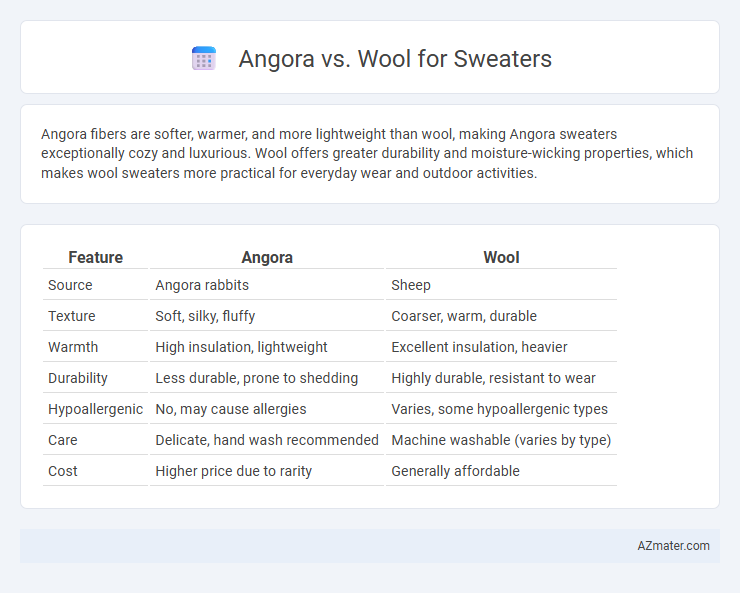Angora fibers are softer, warmer, and more lightweight than wool, making Angora sweaters exceptionally cozy and luxurious. Wool offers greater durability and moisture-wicking properties, which makes wool sweaters more practical for everyday wear and outdoor activities.
Table of Comparison
| Feature | Angora | Wool |
|---|---|---|
| Source | Angora rabbits | Sheep |
| Texture | Soft, silky, fluffy | Coarser, warm, durable |
| Warmth | High insulation, lightweight | Excellent insulation, heavier |
| Durability | Less durable, prone to shedding | Highly durable, resistant to wear |
| Hypoallergenic | No, may cause allergies | Varies, some hypoallergenic types |
| Care | Delicate, hand wash recommended | Machine washable (varies by type) |
| Cost | Higher price due to rarity | Generally affordable |
Introduction: Angora vs Wool Sweaters
Angora sweaters are made from the soft, silky fur of Angora rabbits, offering exceptional warmth and a luxurious feel compared to traditional wool sweaters. Wool, derived from sheep fleece, provides durability, breathability, and excellent insulation, making it a popular choice for cold-weather garments. While Angora fibers are finer and lighter, wool fibers tend to be more robust and moisture-wicking, influencing the overall texture and performance of each sweater type.
Understanding Angora: Source and Characteristics
Angora fibers come from Angora rabbits, prized for their exceptional softness, lightweight warmth, and silky texture, distinguishing them from traditional sheep wool. Unlike wool, Angora fibers have a unique hollow structure that enhances insulation while remaining breathable, making sweaters exceptionally cozy without heaviness. Its natural luster and fine diameter contribute to a luxurious feel and subtle sheen, often blended with wool for durability and elasticity in high-quality sweaters.
Wool Sweaters: Types and Properties
Wool sweaters come in various types, including Merino, Shetland, and Cashmere, each offering unique properties such as warmth, breathability, and softness. Merino wool is highly prized for its fine fibers, providing excellent insulation and moisture-wicking abilities, making it ideal for both everyday wear and outdoor activities. Durability and natural elasticity characterize Shetland wool, while Cashmere delivers superior softness and lightweight warmth, making wool sweaters versatile for different climates and occasions.
Softness and Comfort: Angora Compared to Wool
Angora fibers, sourced from Angora rabbits, offer superior softness and a luxurious, silky texture compared to traditional sheep wool, making Angora sweaters exceptionally comfortable against the skin. Wool, depending on its type, varies in softness but generally provides more breathability and durability, while Angora excels in lightweight warmth and a plush feel. Sweaters made from Angora are ideal for sensitive skin due to their hypoallergenic properties and unmatched softness, though they require more delicate care than standard wool garments.
Warmth and Insulation Differences
Angora fibers, sourced from Angora rabbits, provide superior warmth and insulation compared to traditional wool due to their hollow core structure that traps more air. Wool, primarily from sheep, offers natural moisture-wicking properties and excellent insulation but tends to be denser and heavier than Angora. Sweaters made from Angora are lighter and softer while retaining exceptional heat, making them ideal for cold climates where warmth and comfort are crucial.
Durability and Longevity of Each Material
Angora fibers, sourced from Angora rabbits, offer exceptional softness but tend to be less durable and more prone to pilling compared to traditional wool. Wool, derived from sheep, provides superior resilience and longevity, maintaining its shape and insulating properties even after repeated wear and washing. Choosing wool ensures a longer-lasting sweater with better resistance to wear and tear, while Angora is best for delicate garments requiring gentle care.
Allergenicity and Skin Sensitivity Concerns
Angora fibers are known for their softness but can cause allergic reactions due to the presence of lanolin and other proteins, making them less suitable for sensitive skin compared to wool. Wool varies widely in allergenicity depending on the breed, with merino wool being hypoallergenic and ideal for sensitive skin, while coarse wool may cause irritation and itching. Consumers with skin sensitivity should prioritize wool labeled as super-fine or hypoallergenic and consider Angora alternatives only after patch testing for potential allergic responses.
Care and Maintenance: Angora vs Wool Sweaters
Angora sweaters require gentle hand washing with cold water and mild detergent to maintain their softness and prevent felting, while wool sweaters can often tolerate machine washing on a delicate cycle but should be laid flat to dry to avoid shrinking. Angora fibers are more delicate and prone to shedding, so storing these sweaters in breathable garment bags and avoiding friction is essential. Wool sweaters, though more durable, also benefit from regular airing and moth prevention measures to extend their lifespan.
Price and Sustainability Considerations
Angora sweaters typically cost more due to the luxurious softness and rarity of angora fibers compared to conventional wool. In terms of sustainability, wool is generally more eco-friendly as it is a renewable resource with less environmental impact during production, whereas angora raises ethical concerns related to animal welfare and requires careful sourcing to ensure responsible harvesting. Consumers prioritizing affordability and sustainability often lean towards wool, while those seeking luxury and warmth may prefer angora despite its higher price and ethical considerations.
Choosing the Best Material for Your Sweater
Angora wool, sourced from Angora rabbits, offers superior softness and thermal insulation compared to traditional sheep's wool, making it ideal for lightweight, warm sweaters. Wool, known for its durability, moisture-wicking properties, and elasticity, provides excellent breathability and resilience for everyday wear. Selecting between Angora and wool depends on desired texture, warmth, and care requirements, with Angora favoring luxury comfort and wool delivering robust performance.

Infographic: Angora vs Wool for Sweater
 azmater.com
azmater.com